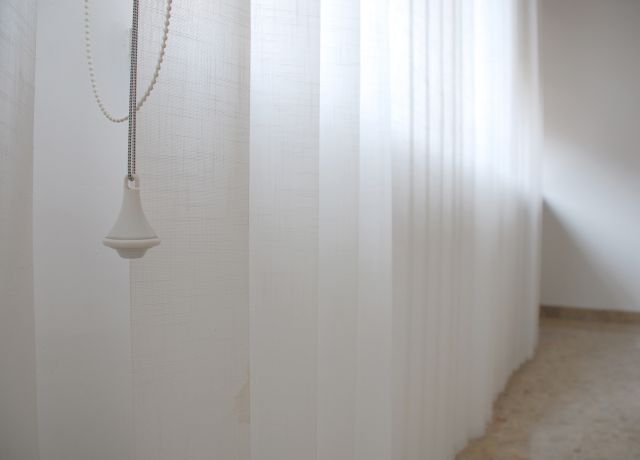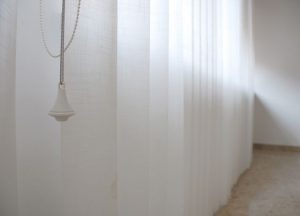Recent changes in the safety requirements for homes have spread the responsibility for home safety to everyone involved. Whether you own your home, you’re a landlord or a tenant, some responsibility falls to you. There are now equal responsibilities to ensure that internal window coverings involving curtain and blind cords are safe for children. Even if you manufacture or install curtains and blinds in a property, the regulations are the same. The regulations are there to prevent children from being harmed or even killed by an accident involving blinds or curtains with loose cords.
What is the danger of blind cords?
Are you are aware of the danger of loose blind cords? There have been a significant number of fatal accidents involving loose blind cords in Australia. The numbers are magnified when you look around the world. These needless but tragic accidents can be avoided by the removal or securing of loose blind cords. Whether they be from blinds, curtains, tiebacks, chains, or any other type of looping material, they should be addressed.
The issue is that these cords are not always secured, or not easy to secure, and this poses a problem when a child is near. When a child can access a loose cord, then there is potential for a loop to get stuck around their neck. That can happen in the cot, if it is next to a window, or on the floor if the cord reaches all the way down. It’s even a problem if the child can access the cord when climbing on a chair, a sofa or a bed.
What should we look out for?
The issue is not just within the child’s room or nursery, but every cord in the home is a potential threat to a playing or inquisitive child. The danger with window blinds and curtains is that we tend to draw the blinds on a daily basis, but we don’t always remember to secure the loop that falls down. When the blind is fully deployed, there is often no loop to worry about, so the tendency is to forget about the loop when we pull the blind up. The simple fact is, there needs to be provision made for the safety of children at all times, and not just when the blind is drawn.
How to prevent the hazard.
There are several ways in which a cord can be made safe. Most of these can be drawn directly from the safety standards for blind and curtain cords. The manufacturer is also required to provide safety advice, so this should also be followed during installation of curtains and blinds.
This is what the regulations require – as per the “Competition and Consumer (Corded Internal Window Coverings) Safety Standard 2014”:
- The must be no loose cord that can form a loop 220 mm or longer at less than 1600 mm above the floor
- No part of the cord guide may be installed lower than 1600 mm above the floor under it can withstand a tension force of 70 Newton for 10 seconds
- The cord shall be fastened to prevent the formation of a loop 220 mm or longer
- A cleat used to secure the cord must be higher than 1600 mm above the floor
- Follow the installation instructions
- The warning label shall be installed with the corded internal window covering – do not remove warning labels!
- This is to be used as a guide, the complete safety standard is available at the address below.
Loose blind and curtain cords can kill. Keep them out of reach of children.
This is a recommendation that is pertinent to everyone, whether it be to protect our own children, our grandchildren, or even those of visiting guests. But the message is that we all need to check our internal window coverings for loose cords, chains, or fasteners and cleats that are not properly attached. This includes both landlords as well as tenants of rental properties in Queensland. Please check your obligations as follows:
-
Parents – check your blinds and curtain cords
- Check for loose cords at floor level. Look for those between the floor and the danger zone of 1600 mm above the floor
- Identify loops in the dangling cords – secure them or remove them
- Ensure that children are not able to use nearby furniture to reach cords
- Secure the window cords so that there are no loops. (This is done with a secure cord tensioner attached to the wall, or by separating the cord so there is no loop.)
- Comply with the National Safety Standards
- Select internal window coverings that do not use cords
- This is useful information for anyone, in any property, even on holidays.
-
Landlords – please be aware of your obligations for curtain and blind cords
- Always install internal window coverings in accordance with manufacturers installation instructions
- Ensure that cleats fasten above the 1600 mm height regulation
- Ensure that all fasteners can withstand 70 Newtons of tension load for 10 seconds
- If in doubt – use a reputable installer or manufacturers agent for installation
- Do not remove warning labels from cords
-
Tenants obligations
- Keep children safe from loose cords from curtains and blinds
- Do not children play with loose cords
- Move furniture away from the potential to reach window cords
- Always supervise children around windows with blind cords.
Reference information:
For more information about National Safety Standards, bans, recalls and emerging issues, refer to this website: www.productsafety.gov.au
In addition to blind cord safety, there are other areas of responsibility to be aware of. Fire safety by way of functioning smoke alarms and pool fence compliance are two other areas to note.
If you would like further information on any of these factors, please don’t hesitate to call Position One Property on 07 3843 4511.


